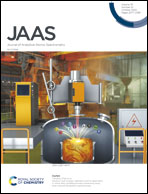Iterative multi-energy calibration and its application in online alloy smelting process monitoring using laser-induced breakdown spectroscopy
Abstract
This report proposes an iterative multi-energy calibration (IMEC) method for online alloy smelting process monitoring and describes its performance verification on online laser-induced breakdown spectroscopy (LIBS) monitoring equipment in application factories. The proposed IMEC method is an improvement upon the existing MEC method; it involves two stages: standard sample preparation and implementation of a quantitative analysis algorithm. Compared with the internal standard (IS) method, the average root mean square error (RMSE) and relative standard deviation are improved from 0.19 wt% to 0.11 wt% and from 2.2% to 1.1%, respectively. To evaluate the IMEC performance more scientifically, a ‘bootstrapping’ method was employed, in which 10 000 sets of data sequences were reconstructed from real data and inputs for IMEC. With this statistics-based approach, the average RMSEs for the IMEC and IS methods were found to be 0.084 wt% and 0.185 wt%, respectively. Furthermore, the IMEC convergence graph indicated that the prediction RMSE quickly decreases to approximately 0.080 wt% and stabilises within 40 iterations. The proposed IMEC method has important potential applications in industrial-grade LIBS online quantitative analysis.



 Please wait while we load your content...
Please wait while we load your content...